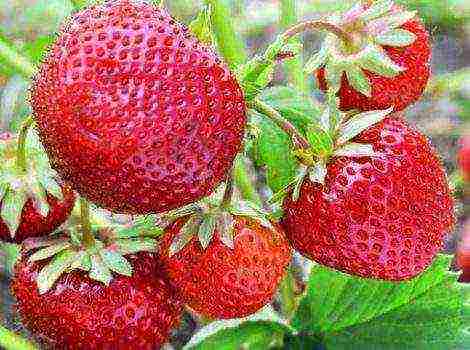Content
- 1 Gelenium: photo of flowers and description
- 2 Peculiarities
- 3 Care
- 4 Pests and diseases
- 5 Preparation stages before planting gelenium in open ground
- 6 Technology for planting gelenium in open ground
- 7 About caring for helenium
- 8 Description of Gelenium
- 9 Growing conditions and proper care
- 10 Growing helenium seeds at home When to plant
- 11 How to sow Hellenium seeds in the ground When to plant
- 12 Hellenium transplant and reproduction by dividing the bush
- 13 Gelenium in landscape design
- 14 Types and varieties of gelenium with photos and descriptions
- 15 Gelenium in the photo
Added 06.12.2017 perennials, autumn, planting, varieties
Bright orange-golden colors are characteristic of the autumn garden and one of the main participants in the September parade of flower beds is perennial helenium (Helenium). Under this name, different types of geleniums can be combined: G. autumn (H. autumnale) - the ancestor of many existing hybrid forms and varieties;G. spring (H. vernalis) and G. Bigelow (H. bigelovii). Most of the varietal plants, most often used by landscape designers in recent years, belong to helenium hybrid (H. x hybridum). There are also annual species, but we will not consider them in this article.
The content of the article:
- Description of gelenium
- Modern varieties of geleniums
- Low-growing varieties of gelenium (photo)
- Medium-sized varieties of helenium (photo)
- Tall varieties of gelenium (photo)
- Correct fit and care secrets
- 5 steps to lush bloom
- Reproduction of helenium by division
- Growing from seeds
- Geleniums in garden design
- What colors should I combine?
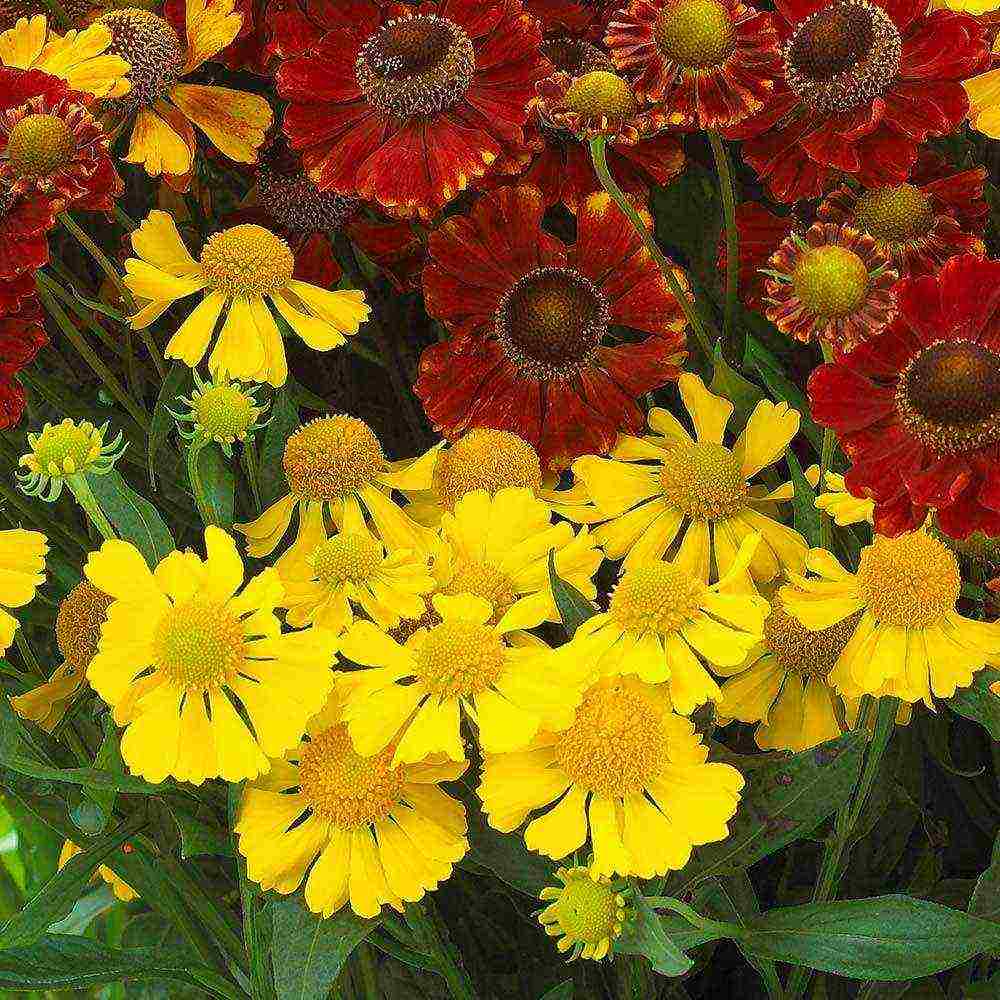
Helenium hybrid
Gelenium: photo of flowers and description
The main feature of helenium is that it is not one bush, but many independent plants growing tightly to each other. The height of the flowering stems ranges from 60 to 180 cm, depending on the variety. The size of the "chamomile" is from 3 to 6 cm, the flowers are collected in thyroid-shaped inflorescences and each stem bears up to hundreds of small "suns". The color of the marginal ligulate flowers varies from light yellow to dark red, and can be two-colored. The flowering time depends on the variety, but the plants, if desired, can be selected so that they are decorative from mid-July to early September.
Modern varieties of helenium can be conditionally divided into 3 groups: undersized (from 50 to 90 cm), medium-sized (from 90 to 120 cm) and tall (from 120 cm and above). Among the names, German names often come across and this is not surprising, because helenium is considered the national flower of Germany.
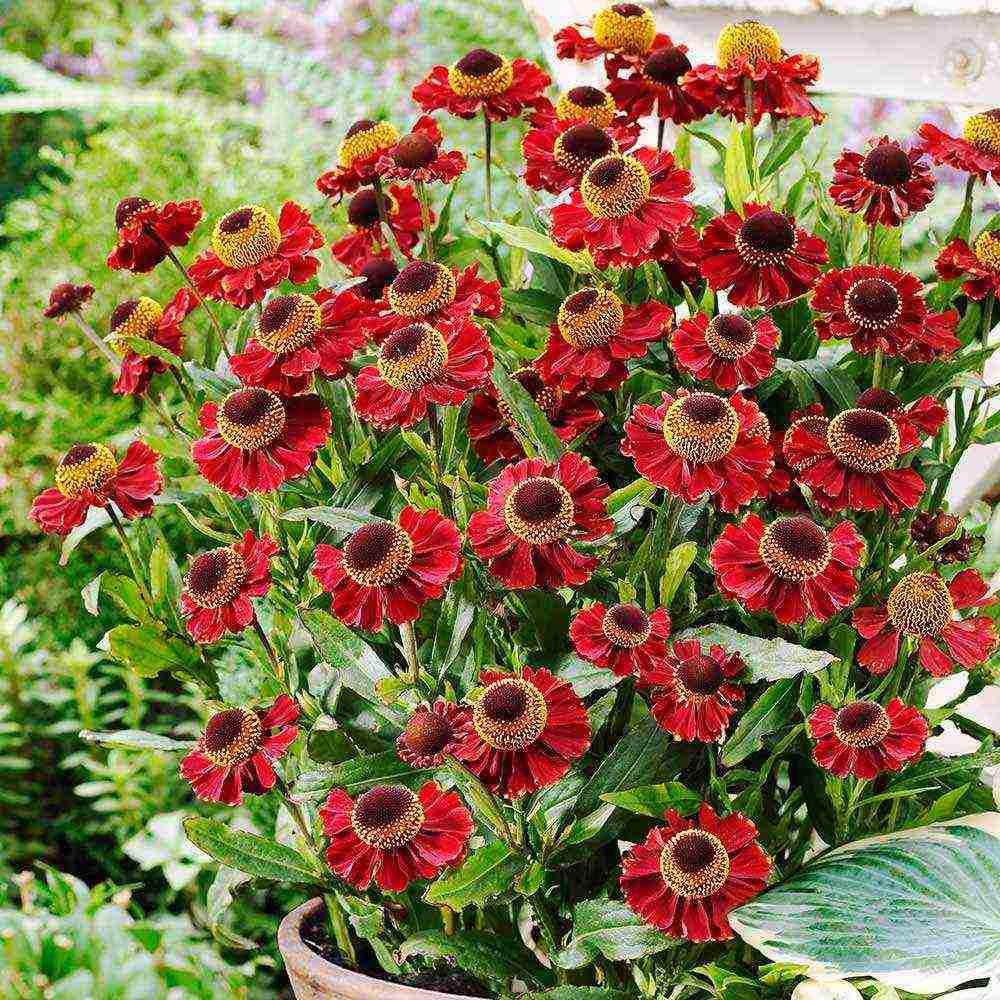
Gelenium perennial ‘Ruby Tuesday’, height (H) 50-60 cm, blooms from July.
Flower helenium (Latin Helenium) Is a genus of annuals and perennials of the Asteraceae family, numbering 32 species that grow in Central and North America, mainly in the West of the United States. It is believed that the helenium plant is named in honor of the wife of Tsar Menelaus, the beautiful Helena, because of whom the war between Greece and Troy, described by Homer in the Iliad, broke out. What are the specialties of helenium flowers? First of all, just by its unremarkableness - for the time being. When at the end of summer the riot of colors in the garden subsides, you suddenly discover with interest somewhere on the sidelines a modest bush of helenium, which you did not notice yesterday. And today, his golden baskets, which can change their color, attract your attention with their not very elegant, but warm, calm and cozy beauty ...
Peculiarities
Location: heleniums are photophilous, but they tolerate partial shade.
The soil: prefer fertile, well-cultivated and moisture-rich neutral soils.
Care
When placing geleniums in the garden, remember where and how they live in nature: moist fertile meadow soils, dense forbs.
They will feel great in densely planted flower beds. Low-growing varieties can be planted in the foreground or in curbs, tall ones in the background. Majestic bushes look beautiful as tapeworms against the backdrop of the lawn... In this case, they need regular watering, since they do not tolerate overdrying the soil well.
We must not forget about watering in dry and hot summers. Geleniums respond well to mineral and organic fertilizing, which is sufficient to carry out two or three times per season. After three to four years, you need to think about a transplant - the bushes age quickly. It is undesirable to spend it in the fall. If you did buy blooming helenium at the end of the season, cut the stem to a height of 10–12 cm before planting and try to injure the root system as little as possible.
Those who grew geleniums know that for all its unpretentiousness, an adult and quite healthy bush in the Moscow region may suddenly not overwinter, although the plant is recommended for the fourth climatic zone... This is due to the peculiarities of its structure.
The autumn helenium bush can only be called a bush. Strictly speaking, this is a colony of independent plants. Flowering stems, like many perennials, live only one season. But, unlike them, at the end of the season, not only the stem, but also the root collar dies off at the helenium, and the renewal buds at the base of the stem by this time often form small rosettes.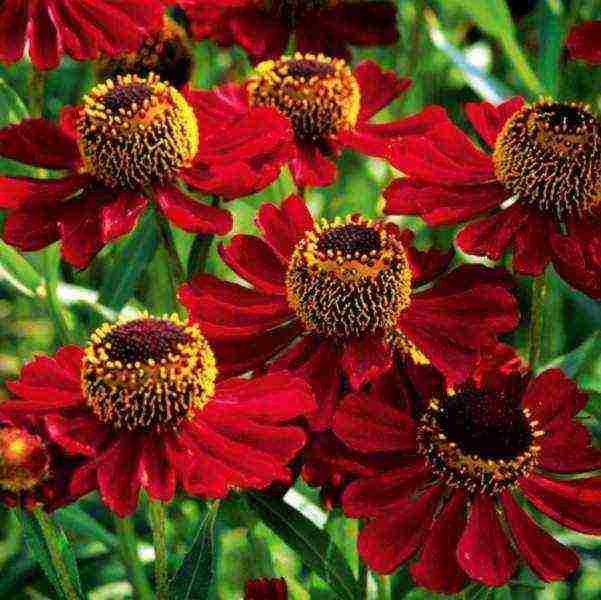 They are independent plants with their own completely autonomous root system. If the winter is snowy or without severe frosts, young plants winter well, and in frosty and snowless ones they easily freeze... This circumstance is aggravated when we are dealing with varieties, in the creation of which other types of heleniums were used, in particular, the more thermophilic helenium Bigelow.
They are independent plants with their own completely autonomous root system. If the winter is snowy or without severe frosts, young plants winter well, and in frosty and snowless ones they easily freeze... This circumstance is aggravated when we are dealing with varieties, in the creation of which other types of heleniums were used, in particular, the more thermophilic helenium Bigelow.
When preparing for winter, mulch the plant with moss or sawdust and cover with lutrasil. Prune and mulch mature plants for better wintering.
Types and varieties
In nature, there are about 30 species of this perennial, but only 5 of them are cultivated:
- Autumn Gelenium (pictured). Reaches a height of 1 meter. Proper care promotes vigorous flowering from August to October. This species served as the basis for breeders to recreate many varieties that have not only larger flowers, but also a flowering period that is one to two months longer. To determine the variety that is needed specifically for your garden, look at the photo and decide. The most common varieties of this species are Pumilum Magnificum, Bruno, Kupfersprudel, Butterpat.
- Gelenium Chupa (H. hoopesii) - has bright yellow flowers, reaching 10 centimeters in diameter.
- Gelenium Bigelow (H. bigelovii) - reaches a height of 80 centimeters. The flowers are large, yellow, very bright.
- Spring Gelenium (H. vernalis) is a very unpretentious and winter-hardy species.
- Helenium hybrid (H. x. hybridum). It includes many hybrid varieties, the origin of which is unknown. They have different sizes, shapes and colors of flowers. They are all very beautiful, see the photo. The height and duration of flowering also vary. Main varieties: Gartcnsonne, Goldlackzwer, Rothaut.
- Gelenium is perennial. The name speaks for itself - it is a perennial variety. Planting and caring for this variety does not differ from the previous ones.
Reproduction
Gelenium reproduces in two ways.
Reproduction by rosettes
Experienced gardeners recognize this method as the simplest and most effective. The thing is that these flowers have one very interesting feature - before the onset of winter, the whole plant dies off, but many buds remain in the ground. Closer to spring, rosettes of leaves sprout from the buds, which are used as planting material. They are dug up, divided and seated in several pieces at a permanent place of growth.
Seed propagation
This method is not so effective and simple, since gelenium seeds are poorly germinated. The way out of the situation is sowing for the winter, then the chances of getting seedlings increase.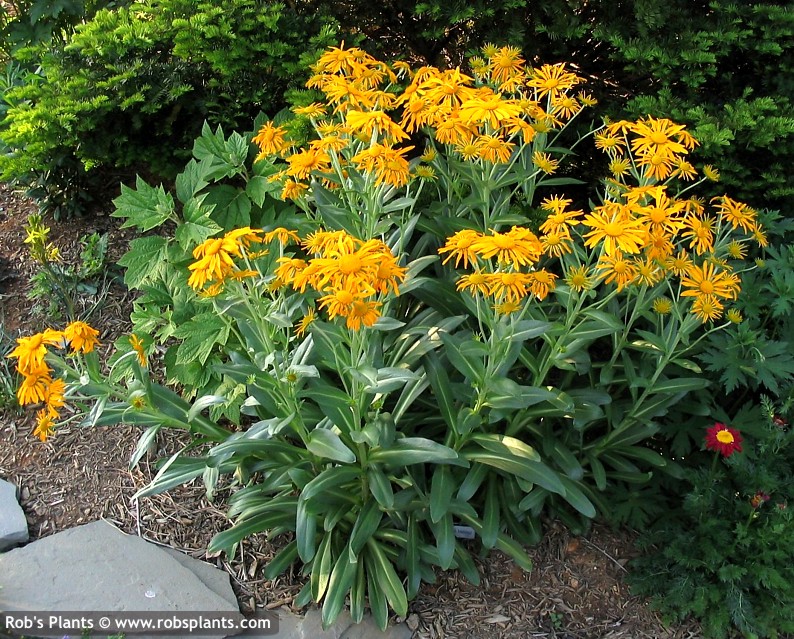
They do it like this:
- Seeds are sown on well-fertilized organic soil.
- After sowing, cover with non-woven material and, not forgetting to water and air, wait for the first shoots to appear.
- When 2 or 3 true leaves appear, the young helenium will dive.
Planting in open ground is carried out in the first decade of June, when the soil warms up enough and the threat of frost has passed.
In this case, the plants should not be planted densely, since their root system grows rapidly. 4 or 5 bushes are enough for 1 m2, but no more.
Using this method of reproduction of gelenium, be patient, because you will be able to admire the flowers only after two to three years.
Pests and diseases
Helenium is resistant to pests, but sometimes it suffers from the chrysanthemum nematode, which damages flower buds and leaves. The affected parts of the plant must be cut off and burned. If the pest was observed on the site earlier, before planting, it is necessary to add ground sulfur (50 g / m2) or hydrated lime (100 g / m2) to the soil. And in the last days of June and July, the plant should be treated with a solution of thiophos (0.2%). Gelenium is practically not susceptible to infections, but it can suffer from waterlogging. Therefore, it is extremely important to monitor the water balance of the soil. Of course, the unpretentious and hardy helenium deserves to live in your garden for many years. This wonderful plant, even with the most minimal care, is able to deliver many happy moments to the grower, prolonging the outgoing summer and joyfully meeting autumn.
Preparation stages before planting gelenium in open ground
Preparation before planting a plant is the key to getting a strong and healthy flower in the future, which will be an excellent decoration for your site. If this beautiful flower is not yet on your site and you have no place to get planting material from, then it is important to purchase high-quality seedlings in the store. Also, take into account all the features of the plant and choose the most suitable place for its active growth on your site.
Stage 1. Selection of seedlings
- It is best to buy helenium seedlings in separate containers in specialized stores. It is better to refuse to purchase planting material in spontaneous markets or from strangers, as you risk getting low-quality material.
- Before buying, ask your consultant about all the features of growing a particular variety of helenium.
- It is also important to carefully examine the seedling. It should not show any damage, signs of disease or pests, dry soil in the container.
- When buying a helenium seedling, you need to take into account the future location of the plants. Get taller varieties for single plantings or planting along the fence, and undersized varieties for framing flower beds.
-
Stage 2. Choosing a site for planting gelenium
Gelenium is a very ornamental plant, so a well-lit area will be an ideal place for its full growth. It is in such conditions that you will get a beautiful plant with abundant and bright flowering. However, this culture does well in light partial shade.
When choosing a place for planting gelenium, take into account the garden composition you have conceived. With these bright colors, you can perfectly decorate nondescript buildings or a fence, and lower grades can be used to frame borders.
Stage 3. Preparing the soil
This culture thrives on fertile, light and permeable soils. The soil should be slightly acidic or neutral. Gelenium is an unpretentious plant, but it is best to prepare the soil before planting. It is important that it is drained, as stagnant water at the roots is also detrimental to helenium. The selected area must be well dug up about the bayonet of the shovel. When cultivating the soil, you can add a little compost, as the plant responds very well to the introduction of various nutrients.
Technology for planting gelenium in open ground
- The optimal time for planting gelenium in open ground is May or early June. It is at this time that the threat of recurrent frosts disappears.
- In a few days, the soil at the planting site is dug up and fertilized with compost.
- Before planting, you also need to prepare helenium seedlings. To do this, they must be carefully removed from the containers and lowered for a while in a container of water so that the roots absorb as much moisture as possible. The approximate residence time in the water should be 5-7 minutes.
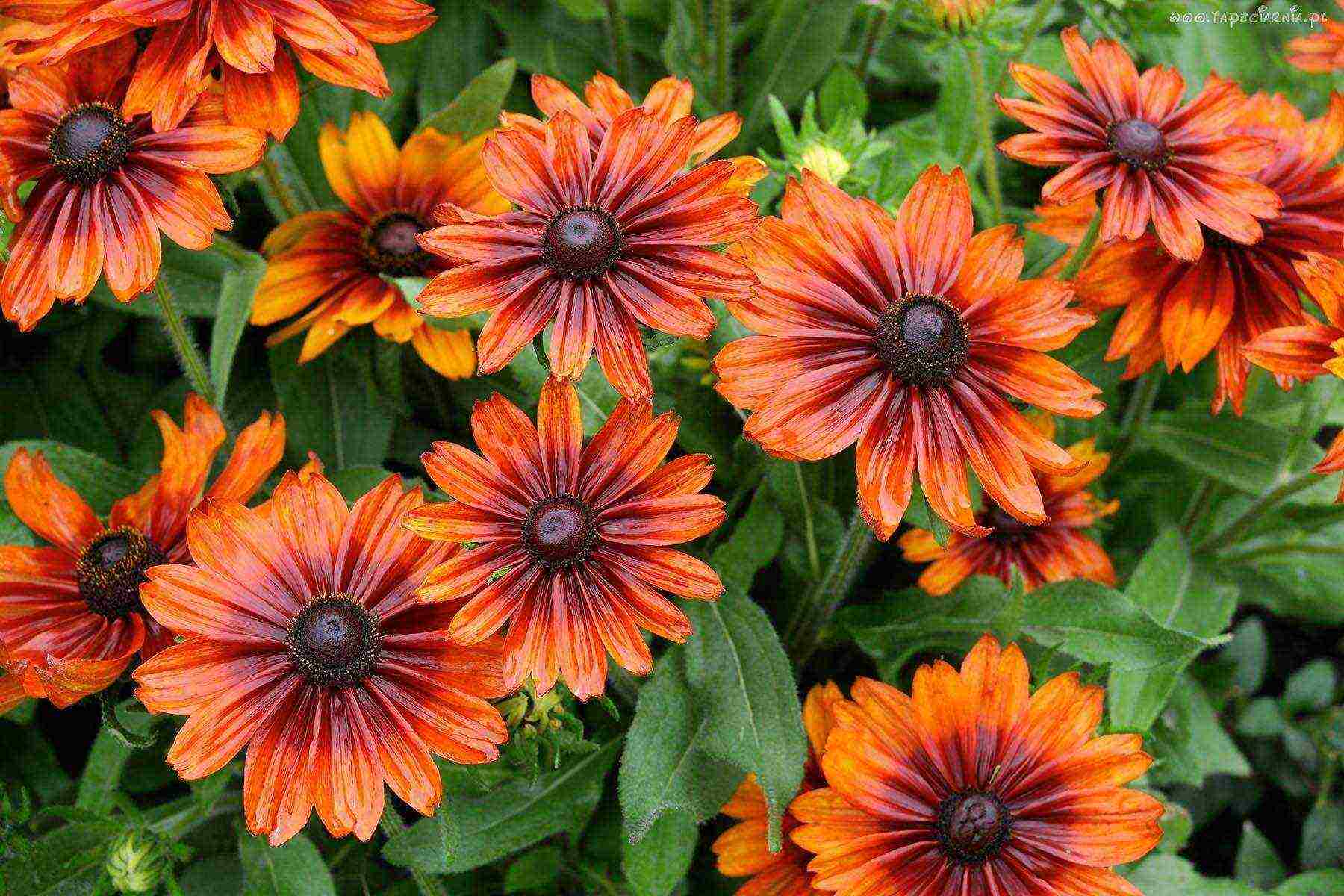
- Next, dig planting holes in the prepared place. Their size should be twice as large as the root system of the seedling together with the earthy clod. The seedlings should be planted no deeper than in the pot.
- If you are planting several seedlings side by side, then it is imperative to observe the distance between the planting holes and rows. There should be at least 30 cm between the flowers of the helenium, and at least 35 cm between the rows.
- A drainage layer can be placed at the bottom of each pit to prevent moisture from accumulating at the roots. It is recommended to use expanded clay or broken brick as drainage.
- Next, place the seedlings of the plant in each planting hole and sprinkle them with soil, gently tamping them with your hands.
- After planting, the area around the plants should be mulched to prevent moisture evaporation. Dry peat or humus can be used as mulch.
What varieties are in demand and grow well?
The most popular Gelenium variety is Rubintswerg. It is distinguished by the rich bright red color of the petals, and their edges give off yellowness. In height, the flowers of Gelenium Rubinzwerg reach 60 cm, and bloom in early July and delight the eye until mid-September.
If you want to see flowering in the middle of summer, then it is worth planting a red-yellow helenium Lava bush. The petals of this species of perennial seem to be velvety, have a rich pearl-burgundy color. The plant will bloom in early or mid-July and will delight you with a riot of colors until the end of August. Its flowering period is more than 60 days. Gelenium Lava winters without shelter, grows up to 1-1.5 meters in height, even a photo of this variety in flower beds looks very bright.
Also of interest are the varieties of Gelenium Cockard and Canaria, whose flowers grow 1.2 meters up, and the variety Moerheim Beauty. In the countries of Europe and America, this type of garden flowers is very fond of and is planted literally in every yard. In Russia, Belarus and Ukraine, hybrid helenium is most often planted.
Gelenium after flowering How and when to harvest gelenium seeds.
If you want to harvest gelenium seeds, you must have time to do it before the lingering autumn rains, otherwise the seeds will rot. That the seeds are ripe, you will be prompted by darkened reed flowers and blackened tubular ones. But, as already mentioned, it is better to buy helenium seeds in specialized stores, since the seeds you collect, with all your efforts, may not sprout, and if they do, it is not a fact that you will get what you sowed as a result. Don't waste your efforts, buy seeds or use vegetative propagation methods for helenium.
Gelenium in winter.
For the winter, the stems of helenium are cut almost to the surface of the earth, leaving only 10-15 cm of stems. After pruning, the site is mulched with moss or sawdust and covered with lutrasil on top in case of severe frosts or a snowless winter.
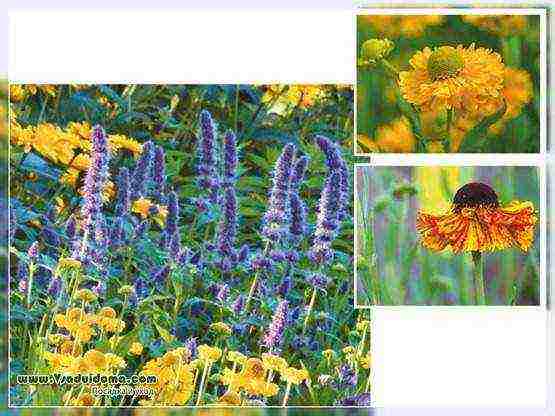
Gardeners have long included this plant in the list of favorites, it is invariably adored by the bees, and the neighbors in the flower garden cherish close friendship! It is not surprising that breeders became interested in our hero and bred varieties with a new color and shape of flowers. Let me introduce you, familiar stranger Gelenium!
Helenium is one of those rare herbaceous perennials that have made it easy to move from traditionally rustic gardens to modern flower gardens.
What is the secret of such a dizzying "career" and popularity?
The decisive role was, of course, played by the lush and colorful flowering.
From late June to September, this unassuming, long-flowering plant colors plantings with rich yellow, orange and red lights. And the growth of a bright handsome man is what you need.
Geleniums often grow to a height of one and a half meters or more, making them ideal candidates for planting in the background of flower beds or along fences or walls.
It should be noted that geleniums of some varieties with powerful shoots, for example Rauchtopas, even a strong wind is unable to “lay on the shoulder blades”.
For the rest, support and a place in a quiet corner are still desirable. Tip: to keep tall plants more compact, at the beginning of summer, you can shorten their shoots by half.
Thanks to this procedure, the flowering time also shifts slightly and comes 3-4 weeks later. Alternatively, you should immediately look at the heleniums of undersized varieties, for example, wine red Rubinzwerg or yellow Wyndley, whose height barely reaches a meter.
See also: Physostegia flower (photo) planting, types and care
About caring for helenium
Caring for a perennial is simple: you need to provide it with a sunny place, ideally, without stagnant dry air, because of which the flowers droop.
But if the plants are well watered, the helenium, which bowed its head in the heat, will come to life again in the morning and will delight the eye with freshness and vigor.
It is optimally suited to a loamy soil rich in humus.
Also, it is advisable to regularly feed our hero with compost (1 l / m2) and complex mineral fertilizer - then the plant will bloom from year to year, without requiring division and transplantation. Is it necessary to rejuvenate the handsome man, he will tell himself - if the bush in the center is bare, then it's time. In general, the plant needs to be rejuvenated every 3-4 years, since, having reached maturity, helenium often freezes. And the last thing: on the eve of winter, all shoots can be safely cut off at the very base.
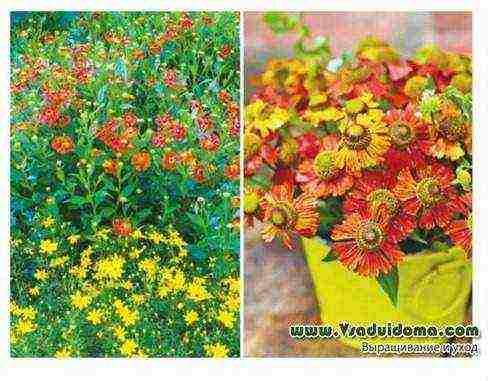
In front of tall geleniums, such as copper-red Baudirektor linne (130-150 cm), it is advisable to plant a number of shorter herbaceous perennials, for example, whorled coreopsis (pictured), anaphalis, catnip or shrub aster.
Gelenium is a great option for a summer bouquet. But keep in mind that you need to cut the stems when the flowers are fully open, since they do not bloom in the water.
See also: Agapanthus in the open field (photo) - planting and care
In the photo above
Double Trouble is one of the first heleniums with a double row of marginal reed flowers. The yellow "suns" plants soar on strong peduncles at a meter height above the ground.
Waltraut is a hybrid up to 90 cm high with large red-orange flowers with a chocolate-brown center. The buds bloom en masse in August - September.
Below are other entries on the topic "Cottage and garden - do it yourself"
Drooping reed - care, photo and reproduction: Drooping reed (Scirpus Cernuus) Herb ... Planting strawberries: master class and photo: How to plant strawberries correctly - ... Securinega semi-shrub (photo) planting and care: Growing securinega - planting and ... Schlumberger - photo, care and reproduction: Schlumberger (Schlumbergera) - growing and ... Reproduction and care of pinnate carnation: Pinnate carnation - for a bush ... gravilata (photo) description and care: Varieties and types of handsome gravilata, ...
Subscribe to updates in our groups.
Let's be friends!
In many gardens and flower beds such a beautiful and sunny flower grows - helenium.According to legend, this lovely plant, delighting with its flowering on the eve of the beginning of autumn, received such a unique name in honor of the beautiful Elena, wife of Menelaus, whose charm was so admired by the admirer of Paris. Probably, the golden tone of this flower resembled the color of Elena's golden curls.
Description of Gelenium
For the first time, the helenium flower was discovered in the region of Central and North America. Today, more than 30 species of this perennial herb are known. Geleniums are not endowed with a long-term developed rhizome. Strong flowering stems dry out after the onset of autumn frosts along with the roots.
But during their withering away, living buds that have appeared on the ground part of the plant form a rosette of leaves with roots. It is this new rosette that forms the flowering stem for the next year. Geleniums do not have the shape of a bush, they are independent plants, closely spaced to each other.
They have straight stems, they branch upward, reaching 160 cm in height. Lanceolate leaves are arranged in the next order. They give inflorescences in the form of baskets, single or collected in corymbose plants. The outermost flowers are purple, yellow, orange or two tones, the central ones are yellow or brown. As a result, they give cylindrical achenes, slightly pubescent.
Growing conditions and proper care
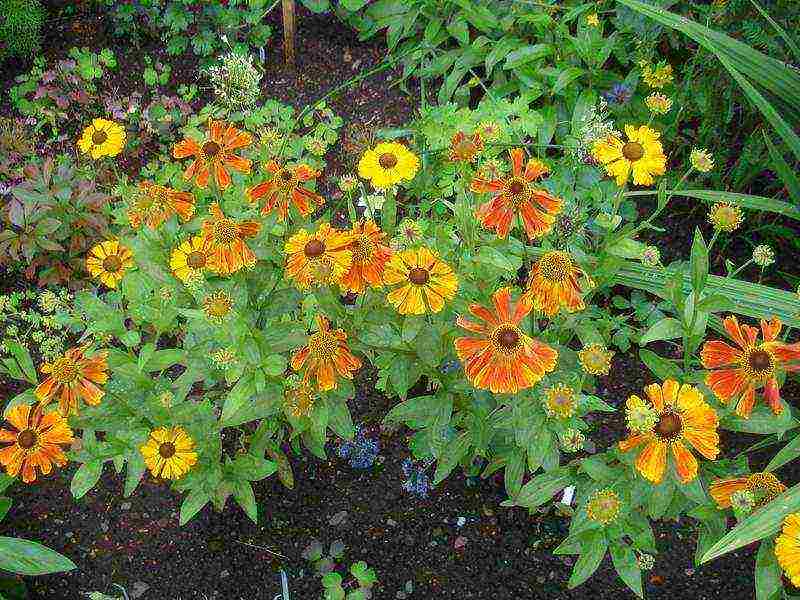
How to plant helenium in open ground photo
Beautiful geleniums prefer well-lit areas, they do not tolerate shading. To plant them, you need to select fertile soils that have a sufficient amount of moisture, a neutral level of acidity.
When planting lush heleniums in a garden, one should take into account the peculiarities of growing in a natural environment: plants prefer fertile meadow soils with a sufficient level of moisture, where forbs grow.
- Densely planted flower beds are an excellent habitat for geleniums.
- Low-growing varieties can be planted on the front of a mixborder or as curbs, tall ones look great in the background.
- Lush bushes look great as tapeworms against the backdrop of a neat lawn.
- Geleniums love regular watering because they do not tolerate droughts.
It is necessary to pay special attention to growing heleniums during the period of dry summer heat. They respond well to feeding with natural organic matter. Such procedures must be carried out three times during the entire active growing season.
After 4 years of growing gelenium in one place, you should seriously think about transplanting, because plants quickly age and degenerate. It is advisable to do this procedure in the autumn. If at the end of the summer season a blooming helenium was acquired, then before planting it, the upper part of the stem is cut off so that a height of 12 cm remains, we plant it carefully, without affecting the root system.
- Experienced gardeners know that helenium bushes can not withstand the harsh winter of the Moscow region. To provide the plant with a better chance of survival, in the winter it is better to cover the bush with fallen leaves, spruce branches or artificial covering material, and in winter it is imperative to make sure that there is snow on top, especially in severe frosts.
The outer flowering stems of helenium live the whole season, dying off for the winter, like all perennials. But, unlike everyone else, even the root neck dies off at the end of the warm season. It is renewed by the buds appearing at the base of the stem. In a snowy winter without severe frosts, geleniums winter well, but in a harsh, snowless winter they can freeze out.
- The susceptibility to cold is increased in hybrid varieties of helenium, which are especially thermophilic.
During the preparation of the plant for winter, it is worth thoroughly mulching the plant with moss or sawdust, you can cover it with ready-made lutrasil. For the plant to winter comfortably, you need to cut off the tops of adult plants in front of the shelter.
Growing helenium seeds at home When to plant
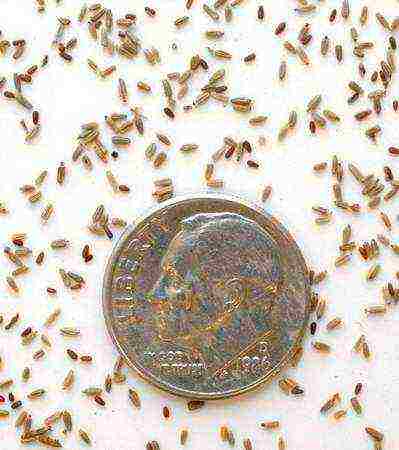
Gelenium seeds photo How to grow helenium from seeds
Planting helenium seeds for seedlings at home is very simple. You can sow as early as the twentieth of March.
- The soil is prepared loose, enriched with organic matter, peat and sand are added. But, of course, it is better not to suffer and purchase a ready-made soil mixture for flowers.
- Although the seeds are very small, it can take a little longer to arrange them further apart.
- Often they sow directly into a common container, so that they can be opened later. Leave 2-3 cm between seeds, do not save space excessively so that the seedlings do not stretch out.
- If you are patient, plant two or three seeds in separate pots, it will be easier to care for the plants, you do not need to transplant seedlings, and the flowers will come out much earlier, since we will not waste time on the survival of the sprouts when picking.

Gelenium seedlings photo What does the seedlings of helenium look like Seedlings of helenium Planting and care
- If sown thickly, when 2-3 true leaves appear, you will have to dive into prepared cups.
- We irrigate regularly, but without fanaticism: the water should not stagnate. Do not forget about the drainage holes in the bottom of the container so as not to provoke rotting roots or black leg disease.
- The lighting needs to be bright, the Hellenium loves light and develops well with long daylight hours. if the room is dark, do additional lighting.
- Planting seedlings begins in mid-May, if there is no night frost. Therefore, it is not superfluous to harden at the beginning of the month, taking the plants outside to get used to the sun and wind. Hardened seedlings are much stronger and easily tolerate planting in the ground.
Considering that helenium produces a good, branched bush, it is better to leave a distance of 40-50 cm between the bushes. Not so large flowers or even ground cover can be planted nearby.
How to sow Hellenium seeds in the ground When to plant
Hellenium can be planted directly into the ground. Like any perennial, it is planted in autumn or early spring in order to get seedlings as soon as possible. It is enough to wait for warm weather and soil maturation. Usually this is the end of April - May... Sometimes it turns out to sow even in March, it all depends on the region. In autumn they are planted at the end of September-October.when it is already cold enough for the seeds to not sprout.
- The bed is prepared with loose, well-drained soil; it is better to season heavy clay soils with humus and add sand.
- The distance between the furrows is 30-35 cm.
- We sow less often so as not to break through.
- The sprouted bushes are watered and freed from weeds, loosened the soil.
- When the seedlings grow to a height of 8-10 cm, they can be replanted.
- The remaining plants should be 30 cm apart.
Gellenium is easy to care for, the main thing is to water and prevent soil compaction. It is advisable to loosen it after each watering, shallow, you can even rake if the soil is not heavy. But it is better to mulch the earth and forget about weeds and earthen crust.
Hellenium transplant and reproduction by dividing the bush

Transplantation and reproduction of hellenium by dividing the bush photo
As already mentioned, it is necessary to transplant Hellenium 4-5 years after disembarkation. A developed bush will degenerate over time to rejuvenate the plant and give space for development, and periodic division of the bush with repotting is required.
- Carefully dig in the root and get a bush with a lump of earth.
- Take a knife or shovel to cut the bush into several pieces, being careful not to hit the ground.
- They are planted in deep holes up to 30 cm, on the bottom of which humus is poured.
- The planting level remains the same without deepening the root collar. Keep in mind that the earth will settle, strive so that later the roots do not end up on the surface, which is also very bad.
- Water abundantly to moisten the soil to the full depth of the hole.

How to divide a helenium bush photo Gelenium hybrid planting and care
Sometimes they do this: they dig in the bush around the edges, separating its parts, and leave some untouched.Since the bush has been split, there will be room for new root buds to grow and the plant will rejuvenate. And the separated delenki are planted in a new place.
Gelenium in landscape design
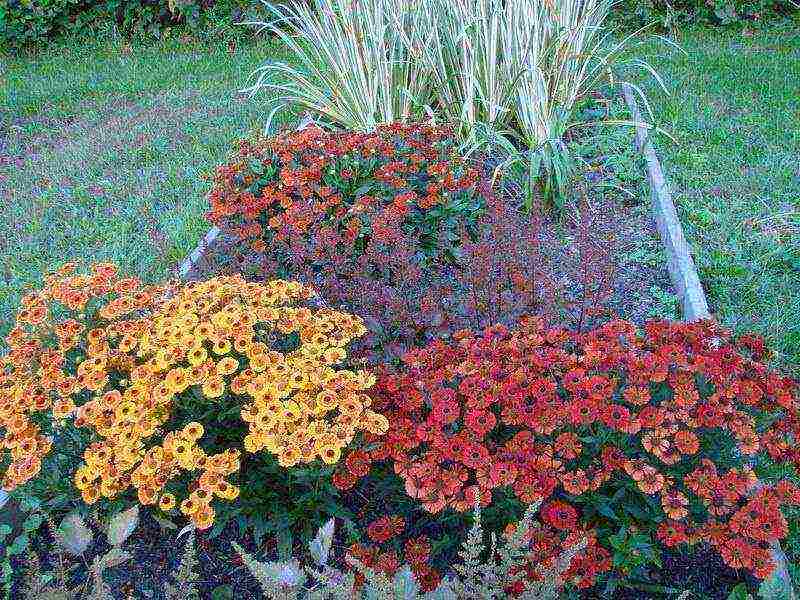
Gelenium photo of flowers seedlings when to plant Gelenium in the garden photo
Gelenium is planted in large flower beds in the background, near ornamental shrubs, in groups or singly. They are used to decorate the fence of buildings. High helenium perfectly coexists with autumn asters.
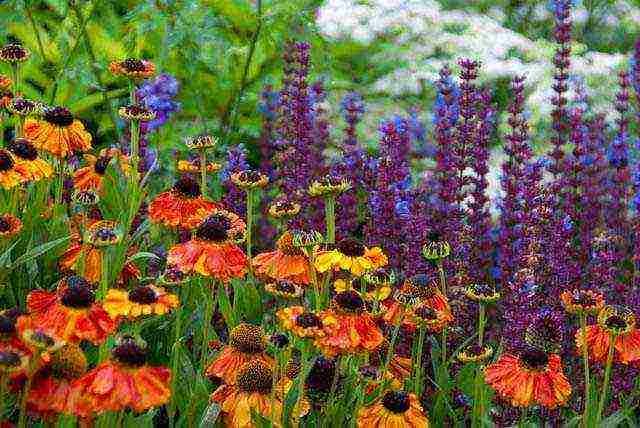
Gelenium hybrid rubinzwerg in landscape design photo
Their inflorescences look great in bouquets and compositions, they are cut off completely blooming, since water does not affect their blooming of buds.
Types and varieties of gelenium with photos and descriptions
Hegenium autumn helenium autumnale
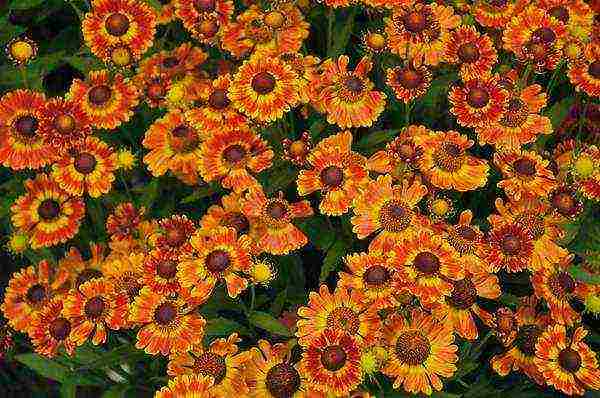
Helenium autumn Fuego Helenium Fuego planting and care in the open field photo
Autumn Gelenium, cultivated since the 17th century, is the most widespread. The abundant late flowering is considered to be the distinguishing advantage of this flower. The bushes of the autumn variety of helenium have a columnar shape. Strong stems of this variety can rise up to 2 m in height.
The upper part is strongly branched. Each branched part ends with a beautiful golden flower, a basket with a diameter of 6 cm. As a result, each stem can have up to several hundred flowers. The autumn variety blooms in early August, beautiful flowering continues for another month, the seeds are fully ripe by October. Currently, there are many unpretentious varieties of this flower that are excellently used in landscaping.
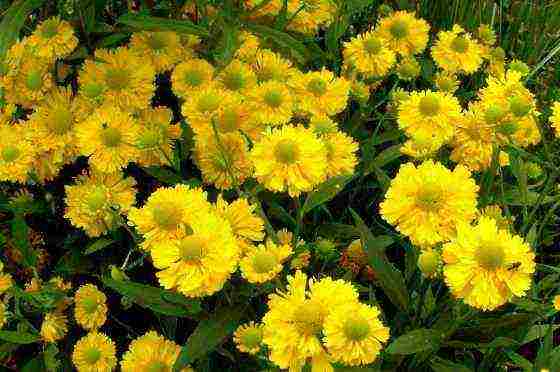
Autumn Gelenium Double Trouble Helenium Double Trouble planting and care photo
Varieties with a yellow marginal flower color are very popular. Among them is the undersized Magnificum, reaching only 80 cm in height. Its middle is classically yellow, it pleases with lush flowering in late July - early August.
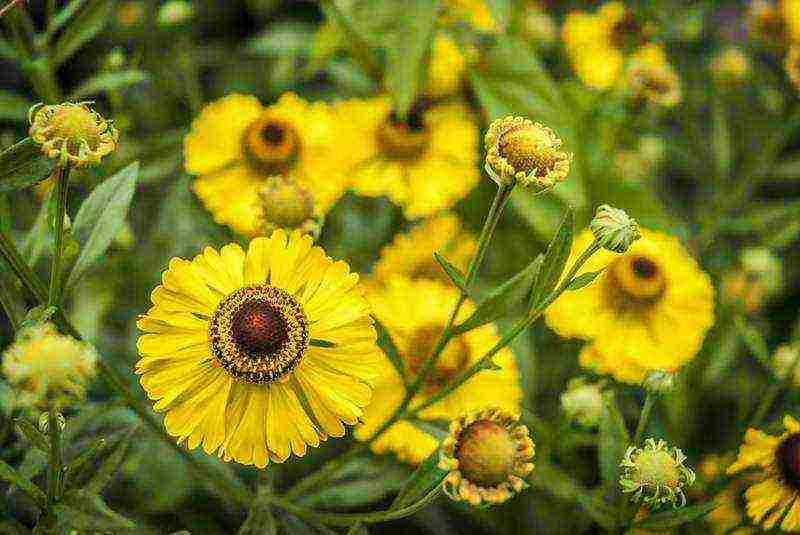
Gelenium Sunrise lemon Gelenium growing and caring for a photo of flowers in the garden
Medium-tall Gartenzonne stretches up to 110 cm, gives lush baskets with a diameter of 6 cm, the middle of the flower is brown. Flowering begins in late July.
The adorable Katarina is 140 cm high, and the middle of her flower is also brown. Lush flowering pleases from mid-August.
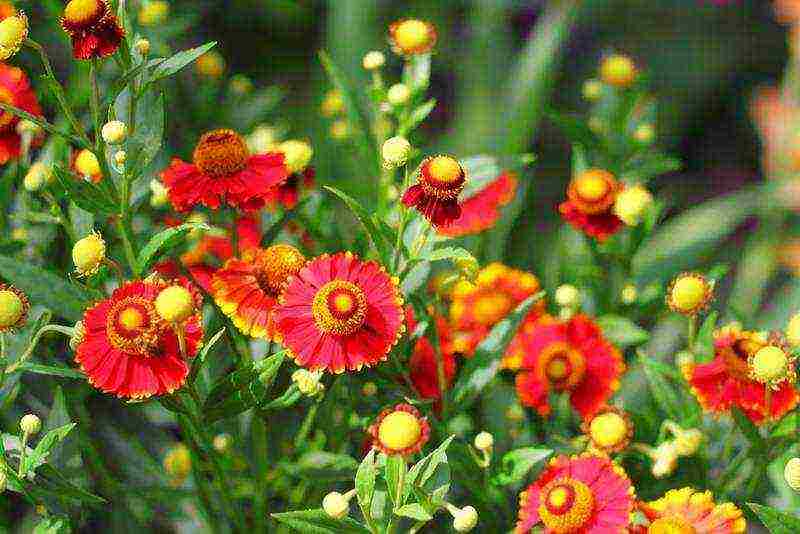
Gelenium autumn sunrise red What does helenium look like photo how to plant helenium
The magnificent variety Moorheim Beauty reaches 180 cm in height, the middle of the flower has a yellow-brown tint. Abundant flowering also begins in mid-August.
They also bred varieties with a red color of flowers. Among them, it is worth noting the medium-tall variety Di Blonde, which has a developed dense bush up to 170 cm high. Its marginal flowers are red-brown in color, the middle is also brown. This variety begins to bloom in mid-August.
An interesting low-growing variety Glutauge, it gives baskets with a diameter of 6 cm, the core of the flowers is red-brown.
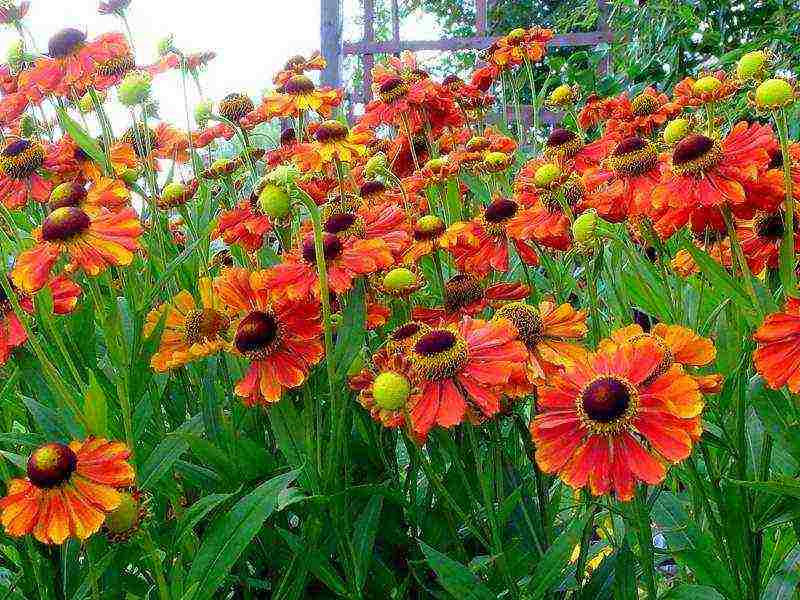
Gelenium Moorheim Beauty Gelenium autumn varieties garden flower helenium photo in the garden
The natural environment for the distribution of heleniums is wet, swampy areas. The roots of the plant are superficial, they are poorly developed. The bred varieties of autumn helenium are cultivated in illuminated areas. The garden soil for them must be provided with proper watering. Sufficiently high grades are tied to wooden stakes. Geleniums have a high growth rate, after 3 years of intensive development, it gives up to 30 new stems.
The plant itself also ages quickly, as it grows in breadth. It is for this reason that in the 4th year of development it is necessary to divide the bush and transplant to a new place. The optimal time for the next transplant is early spring, when the dug out plants easily disintegrate into separate outlets, 2 pieces of them are planted in prepared places.
Strong helenium Chupa Gupesa Helenium hoopesii

Strong helenium gupesa Helenium hoopesii photo of flowers in the garden planting and care
This plant grows comfortably in rocky terrain.It has a developed rhizome, large basal leaves, strong stems. Gelenium gupesa gives rather large baskets with a diameter of 10 cm, its flowers are orange in color. This variety has a long flowering period of up to 40 days, starting in July. Then it begins to bear fruit, has breeding methods similar to autumn helenium.
Helenium hybrid
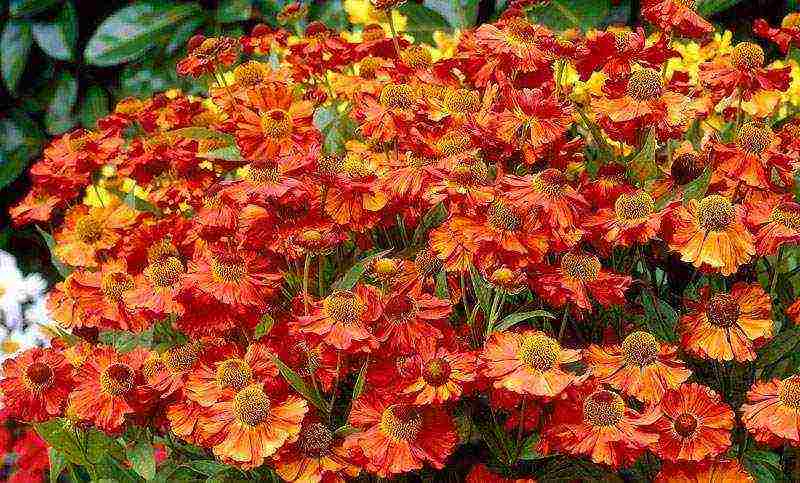
Gelenium bright beauty Garden flower helenium Flowers perennials helenium
This category includes all garden heleniums obtained by crossing the first two forms. They differ in height, shape, color of flower baskets, and have different flowering periods.
Among them, it is worth noting the high variety Gartenzonne, growing up to 130 cm in height, with inflorescences up to 3.5 cm in diameter. The color of the flowers is from reddish-yellow to yellow-brown. Lush bloom is observed from July.

Gelenium hybrid Rubinzwerg Rubinzwerg red helenium perennial photo of flowers planting and care
The medium-sized variety Goldlaktswerg stretches only up to 100 cm. It gives inflorescences of a compact shape, up to 4.5 cm in diameter. The color of its reed flowers is brown-orange, with yellowish tips. Abundant flowering begins in July.
Also in the culture, the Gelenium variety Rothaut is widespread, capable of developing up to 120 cm in height. It is capable of producing inflorescences up to 4.5 cm in diameter. The color of the reed flowers is intensely brown, the tubular inflorescences are yellow-brown in color, lush flowering is observed from July.
Gelenium in the photo
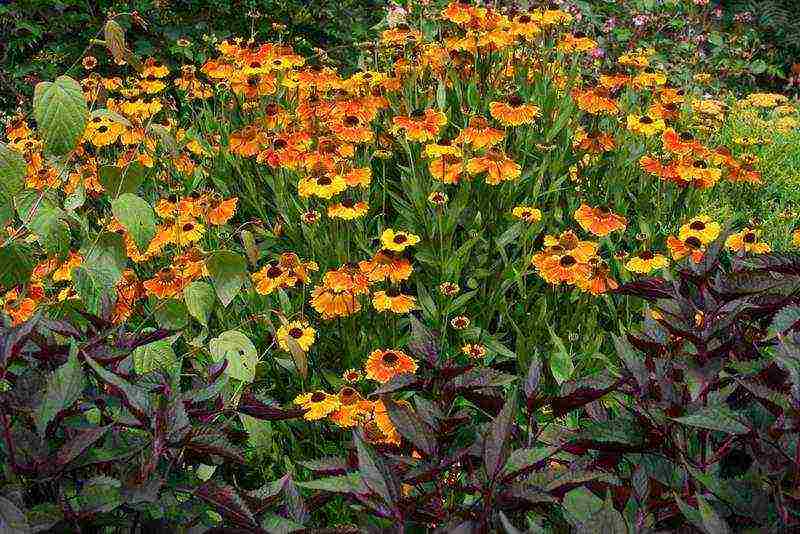
Gelenium flower growing Gelenium when to plant Gelenium in landscaping photo mixborder
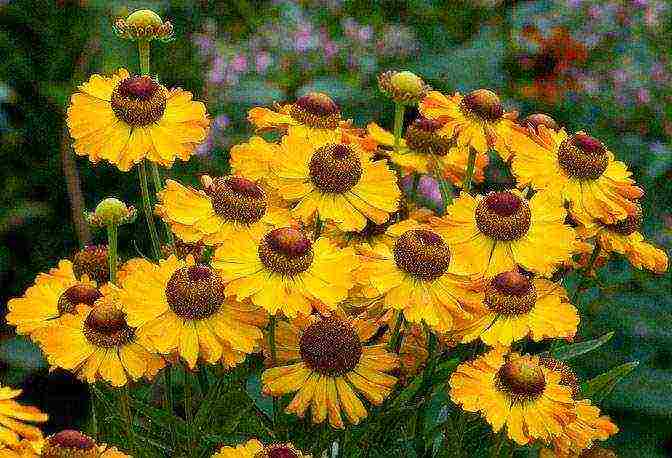
Gelenium autumn photo Planting helenium in the ground
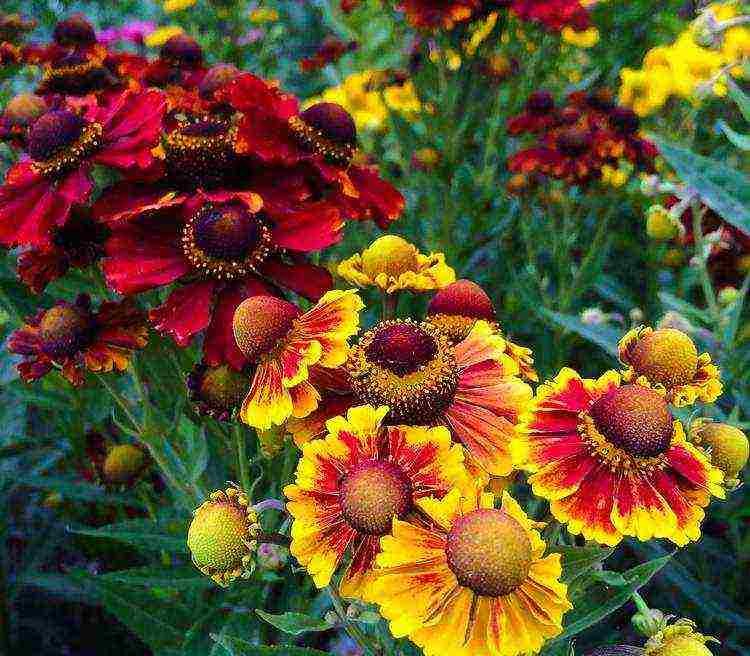
Perennial autumn flower helenium Helenium autumnale description and photo Planting and care


